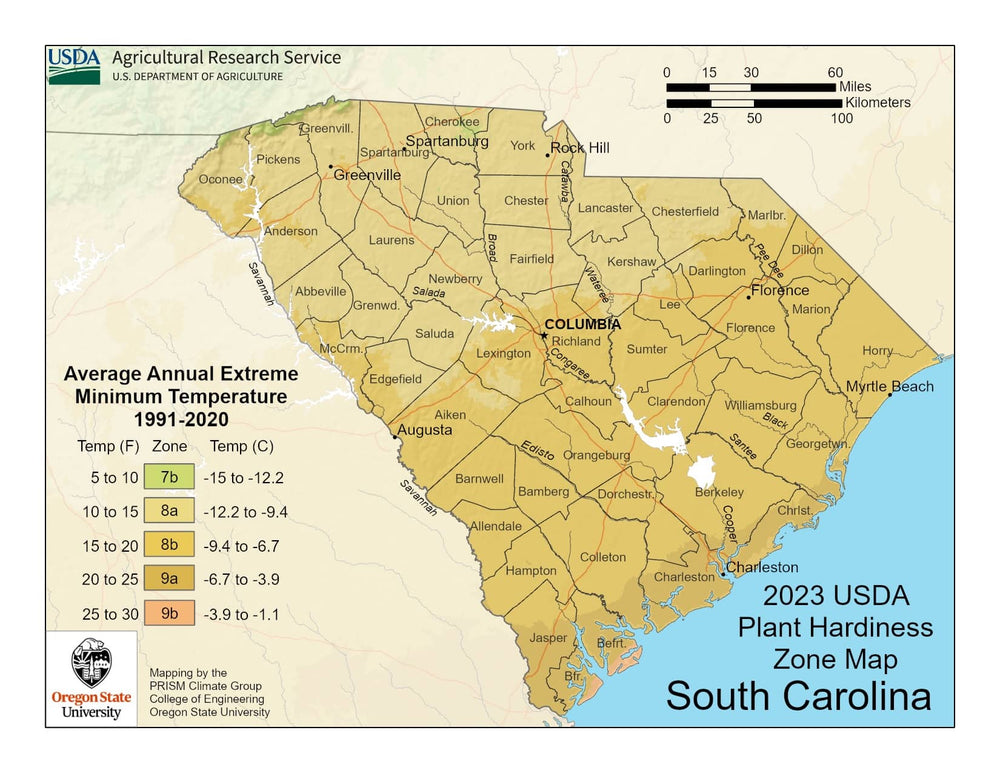Image from USDA
Characteristics of South Carolina’s Planting Region
South Carolina’s climate is considered humid subtropical, marked by long, hot summers and relatively mild winters. Gardeners here benefit from an extended growing season and various crop options.
Typical growing conditions include:
- Hot, humid summers with frequent thunderstorms
- Mild winters with occasional frost, mostly in northern or inland areas
- A long growing season, ranging from 210 to 280 frost-free days depending on the region
- Average high temperatures in the 80s and 90s°F (27°C to 37°C) during summer
- Annual rainfall of about 45 to 55 inches (1143 to 1397 mm), well distributed throughout the year
Lowcountry areas near Charleston enjoy some of the most extended frost-free periods in the state. At the same time, the Upstate region near Greenville may see shorter growing windows due to elevation and cooler temperatures.

Challenges of Growing in South Carolina
1. Heat and Humidity
Summers can be intensely hot and humid, stressing plants, promoting fungal diseases, and limiting the growing season for cool-season crops.
2. Soil Quality
Much of South Carolina has sandy or clay-heavy soils that may drain too quickly or retain too much moisture. Amending soil with compost or organic matter is often necessary to support strong root development and consistent crop yields.
3. Pest and Disease Pressure
The warm climate supports a wide variety of insect pests and fungal diseases. Whiteflies, aphids, nematodes, and fungal blights are common threats. Managing these pests requires vigilance, crop rotation, and sometimes the use of row covers or greenhouse protection.

The Benefits of Using a Greenhouse in South Carolina
While South Carolina offers an extended growing season, the addition of a greenhouse allows you to better manage timing, increase yields, and protect crops from pests and weather extremes.
1. Extend Your Growing Season
- Without a Greenhouse: Gardeners are limited to planting warm-season crops after the last frost and harvesting before the first frost. Cool-season crops must be timed perfectly to avoid heatwaves in late spring and early fall.
- With a Greenhouse: You can start seedlings as early as January and continue harvesting well into December. A greenhouse buffers against unexpected frost or heat and allows for nearly year-round production in many parts of the state.
Learn more about your area's specific growing dates and the best vegetables to plant in each part of South Carolina.

Customer images of their Greenhouse set up in South Carolina
2. Grow a Wider Variety of Vegetables Without a Greenhouse:
-
Without a Greenhouse
South Carolina gardens typically favor warm-season vegetables like:
|
Corn Okra Melons Winter squash Tobacco |
Peaches Cucumbers Beans Cantaloupes Lima |
-
With a Greenhouse
The controlled environment opens up more possibilities, especially for cool-season crops or heat-sensitive varieties:
|
Arugula, Spinach, Broccoli, Cauliflower, Brussels sprouts, Tomatoes, Peppers, Eggplant, Cucumbers, Figs |
melons, Zucchini, Carrots, Beets, Radishes, Kale, Swiss chard, Collard greens, Basil, Cilantro |
Parsley, Rosemary, Thyme, Green beans, Green onions, Leeks, Lemons, Limes, Kumquats, |


